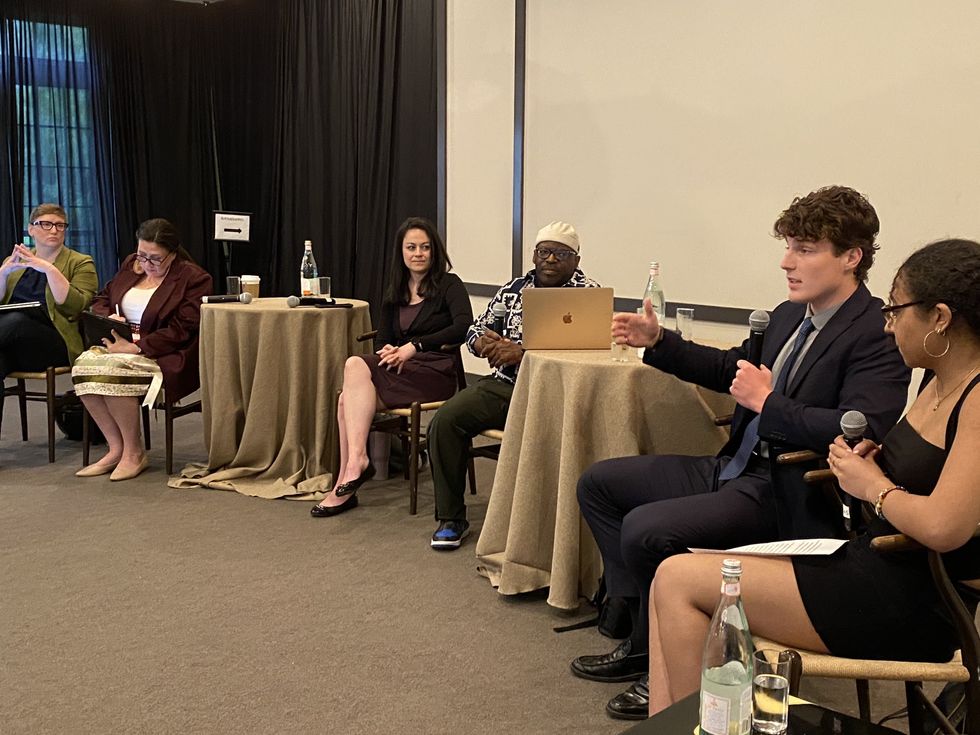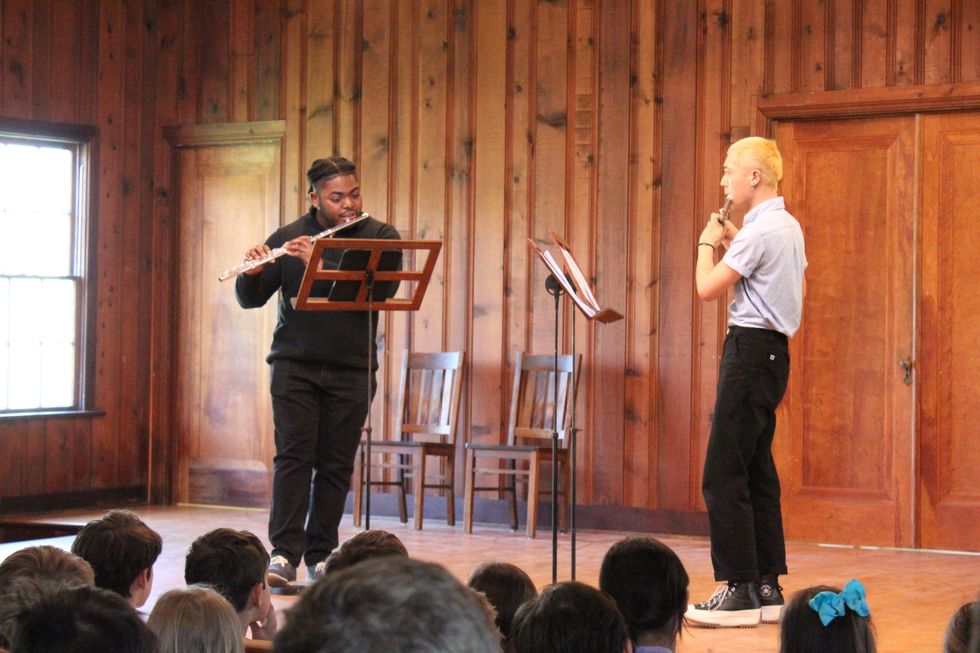Latest News
Participating students and teachers gathered for the traditional photo at the 2025 Troutbeck Symposium on Thursday, May 1.
Leila Hawken
Students and educators from throughout the region converged at Troutbeck in Amenia for a three-day conference to present historical research projects undertaken collaboratively by students with a common focus on original research into their chosen topics. Area independent schools and public schools participated in the conference that extended from Wednesday, April 30 to Friday, May 2.
The symposium continues the Troutbeck legacy as a decades-old gathering place for pioneers in social justice and reform. Today it is a destination luxury country inn, but Troutbeck remains conscious of its significant place in history.
A showing of student artworks within the theme of linking the past with the present opened the symposium on Wednesday evening. Each work of art had to draw on historical research to foster an informed dialogue between the artist and the contemporary audience.
The second day was devoted to student research presentations, showcasing teams from the region’s leading public and private schools with strong programs aimed at cultivating engaged young historians. Primary source materials and live interviews with descendants were included in the process.
Topics were divided into blocks with guest commentators providing reactive response as each block of student presentations concluded. Serving as commentators were Dr. Hasan Kwame Jeffries, Ohio State University, and Dr. Christine Proenza-Coles, University of Virginia.
Resistance in the face of oppression and stories of resilience that spanned generations formed an important theme as students presented the stories of area settlers and residents who suffered but endured.
As a sampling, The Taconic School teamed up with The Salisbury School to unearth untold stories of Boston Corners. The Hotchkiss School looked into the activities of the Ku Klux Klan in Connecticut. The Cornwall Consolidated School students stepped up with their untold stories of early Cornwall women.
Other presentations explored criminal justice — witchcraft trials — dealing with society’s “undesirable” elements, individuals in history who took action, people and movements that formed resistance, and various forms of discrimination.
Praising the work of the students, Dr. Jeffries identified a theme of resistance and survival.
“The war ended but the resistance did not,” Jeffries said. “We don’t take indigenous people seriously,” he added. “White supremacy happened in our own back yards.”
“We saw the evolution of research,” said a Cornwall Consolidated School representative. That project moved into civic engagement by the students that moved beyond the classroom.
“This is not the past; this is part of the present,” said Dr. Proenza-Coles.

The third day invited area history educators to assemble and share ideas for redesigning elements of history education, a day of reflection.
The panel included Jessica Jenkins, Litchfield Historical Society; Wunneanatsu Lamb-Cason, Brown University; Morgan Bengal, Old New-Gate Prison; Frank Mitchell, Connecticut Humanities; and student representatives Dominik Valcin of Salisbury School, and Shanaya Duprey of Housatonic Valley Regional High School.
Valcin reflected on his work as a shared project within The Salisbury School, one where the inquiry would seek to find “the deeper story behind a base story.”
Duprey also spoke of process and the educational value of engaging with historical inquiry.
Each representing a profession that brings them into contact with historical inquiry, the panelists recounted tedious history classes of past decades. Jenkins described her own career as “public history.”Lamb-Canon’s experience began with choosing history electives in college. Bengal spoke of community engagement and the power of involvement with history.
“History is not the opposite of scientific inquiry,” said Bengal.
Significant discussion centered on the possibility of offering the Troutbeck Symposium model to a wider audience of school systems throughout the U.S.
“A community approach to education,” was a characterization offered by Troutbeck owner Charlie Champalimaud, commenting during a brief interview at the end of the symposium on Friday, May 2. She encouraged a push toward increasing even more the number of participating schools, their educational communities and symposium sponsors.
Keep ReadingShow less
Terence S. Miller, owner of Roaring Oaks Florist in the new self-serve area of the shop.
Natalia Zukerman
Just in time for Mother’s Day, Roaring Oaks Florist in Lakeville has launched a new self-serve flower station next to its Main Street shop, offering high-quality, grab-and-go bouquets from 8 a.m. to 8 p.m., seven days a week — including Sundays when the main store is closed.
Owner Terence S. Miller, who bought the shop 24 years ago at just 20 years old, calls the new feature “a modern twist on an old-school honor system,” with some high-tech updates.
“We’re still using our same high-end flowers, just with less markup and no labor,” said Miller. “That way people can access our quality anytime, even if we’re closed.”
Tucked beside the shop’s main entrance at 349A Main Street next to The Boathouse, the self-serve area is partitioned and monitored by security cameras. A simple touchscreen checkout system lets customers pay with a credit card — no cash accepted — and includes photo prompts to make selection easy. Vases, ribbons, flower food, and care instructions are all stocked and labeled.
“We’ve tried to think of everything people might need,” said Miller. “It’s all about making great flowers more accessible without losing what makes Roaring Oaks special.”
Miller said the idea came from years of watching customers try to squeeze in a visit before or after hours. “We’re open 8 hours a day, but we’re here for almost 10, and it still isn’t enough. People are always showing up after we close,” he said. “This way we can be ‘open’ more hours without adding staff.”
Though he considered making the space available 24/7, Miller ultimately decided against it. “We didn’t want to encourage late-night tampering,” he said, noting the shop’s proximity to local bars and restaurants.
Miller’s journey into flowers was unexpected. As soon as he could get his farming papers at 12 years old, he started working at Silamar Farm in Millerton. Alongside its produce, Silamar’s was one of the first farm stands in the area to sell fresh cut flowers.Miller began growing and bundling cut flowers for city-bound customers. “By 16 I needed a year-round job, so I applied to every florist around. I just had a knack for it,” he said. After a stint in Rhinebeck, he returned and bought Roaring Oaks from its previous owner.
In the decades since, he’s built a reputation for quality and creativity. The shop’s flowers are sourced from around the world, particularly Canada and South America, though Miller is committed to supporting local growers wherever possible, especially for summer offerings and weddings.
“We’re hoping to feature some smaller farms in the self-serve section this summer,” said Miller. “DIY weddings have taken off, and people don’t always realize the benefits of buying local. Cold chain is everything. The flowers we source come straight from the airport to the wholesaler and right up here. That’s how we keep them fresh.”
Roaring Oaks also offers consultations and bulk flower discounts for events and weddings, a service Miller hopes more customers will discover through the new self-serve setup.
After 50 years in business, and nearly a decade at its current Lakeville location, Roaring Oaks continues to evolve. “This September marks my 25th year,” said Miller. “I’m always looking for ways to make people happy. Flowers should be simple, joyful, and accessible. That’s what this is all about.”
For more information or to plan your Mother’s Day bouquet, visit Roaring Oaks Florist at 349A Main Street, Lakeville.
Keep ReadingShow less
A string quartet opened the Bard Conservatory of Music program for Region One third grade students at Music Mountain.
Patrick L. Sullivan
Region One third grade students attended a chamber music concert by Bard Conservatory of Music students at Music Mountain Tuesday, April 29.
After expending spare energy racing around the Music Mountain lawn, the children trooped into the concert hall and took their seats.
After a brief introduction from Bard’s Mira Wang, the first item on the program was a string quartet, playing a piece by Haydn.
The students also heard a solo rendition of medieval songs played on the alto trombone, an unusual instrument.
The annual third grade concert is a tradition that stretches back decades at Music Mountain. It’s a treat for the children, and for the music students, who get to experience the incredible acoustics of the Music Mountain concert hall.

Keep ReadingShow less
loading








